
|
|
|
DCSki’s Editor is in the midst of a road trip. He checks in with occasional “Notes from the Road” in this series.
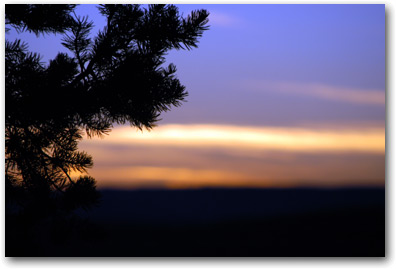
|
|
|
When I last checked in, I had spent three days skiing at Colorado’s Vail Resort. At the tail end of my visit, I started to come down with a sore throat. I chalked this up to three days of rigorous skiing, combined with the cold and high altitude.
Well, it was a bit more than that, which started becoming clear as I drove from Vail to Moab, Utah. Along the scenic drive, I tried to ignore the fact that my sore throat was getting worse and worse. Still, I hoped I could throw whatever it was (a cold? The flu?) after getting to a lower elevation. And I was in the middle of my vacation -; I wasn’t about to let a cold get me down. So I plowed ahead with my plans.
Moab, Utah is one of my favorite regions in the country. Located in southeast Utah, it is far away from everything, offering a weathered landscape that is difficult to describe. Here you can see hundreds of miles into the distance, often without seeing any hint of human settlement. Peer into the distance, and you see the same view Anasazi Indians might have seen a thousand years ago, or earlier civilizations three thousand years ago. (No, Columbus did not discover America. He was pretty late to the party.)
Moab offers numerous opportunities for recreation. Arches and Canyonlands National Parks are nearby, along with countless hiking, Jeep, and mountain biking trails. In the distance, the La Sal mountain range is snowcapped into the summer.
I have written about Moab on two separate occasions in the past (here and here, from trips in 2000 and 1998, respectively), where I discovered the thrill of mountain biking on slickrock trails located throughout the Moab region.
Well, on this visit, I didn’t have my mountain bike with me. But I did have my SUV. In the past, I had a Saturn, which wasn’t quite up to the task of venturing offroad. Suddenly, all of those Jeep roads were within my grasp, and it wasn’t long before I veered off the asphalt onto one of them. This was one SUV that wasn’t going to be destined to a life of pavement driving.
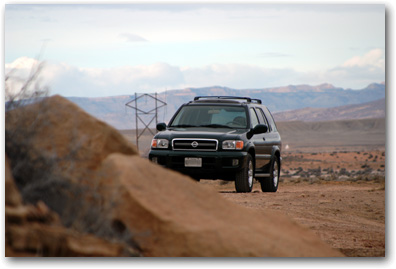
|
|
|
I arrived in Moab in the afternoon and checked into Aarchway Inn, my favorite motel there. In the past I had camped at primitive campsites along the banks of the Colorado River, but now I generally stay at the Aarchway Inn when I visit the Moab region. The relatively new motel is just miles from the entrance to Arches National Park, and offers spacious rooms with air conditioning, a mini refrigerator, and a microwave.
I had visions of taking some sunset photos on my first night, but feeling sick, I decided to head to bed early and plan to wake up early the next day. The next day I felt worse, but stubbornly decided to go hiking anyway. I had wanted to go to Canyonlands, one of the least visited (but most beautiful) National Parks, but chose instead to go to Arches, which was closer.
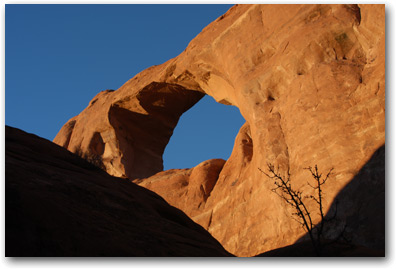
|
|
|
Arches National Park is the result of over 100 million years of erosion. The Park features the greatest density of natural arches in the world, with more than 2,000 cataloged arches ranging in size from a three-foot opening to 306 feet from base to base. A popular tourist destination in the summer, temperatures at Arches can climb above 100. In the winter, temperatures can dip well below freezing, but during my visit, daytime temperatures climbed into the mid-50’s -; perfect weather for hiking.
And perfect weather for visiting Moab. Had I discovered a secret? The scenery around the Moab region looked essentially the same as in the sweltering summer. But the cooler temperatures were perfect for hiking and mountain biking, and meant that one needn’t carry a gallon of water around each day. (It is still easy to get dehydrated, however, and there are far less people around in the winter, so the desert should never be considered forgiving. Even on a warm day, temperatures plunge once the sun goes down.) Was winter the best time to visit Moab?
The problem is wide temperature fluctuations. Mid-50 temperatures are unusual for January; a week earlier, the high hadn’t climbed much above freezing. On average, the high temperaure in January is 44, with an average low of 19. But that’s just average. If you can swing a trip to Moab in the winter during a mild period, you’ll have the best possible conditions. Late fall and early spring are also opportune (and much more crowded) times.
Still euphoric from taking my Nissan Pathfinder offroad, I chose to drive out to the trailhead for Tower Arch. Tower Arch is the most isolated arch in the Park, a moderately difficult 3.4-mile hike from the trailhead. The trailhead is reached from a 9-mile dirt road leading out from the furthest point in the Park. This road was very rough, although still accessible by daring drivers in relatively high clearance vehicles such as a Subaru Outbook. As with all dirt roads in this area, a sudden rainstorm can make the road utterly unnavigatable by vehicles of any type. (Flash floods in desert environments are also a risk; always check the weather before heading out.)
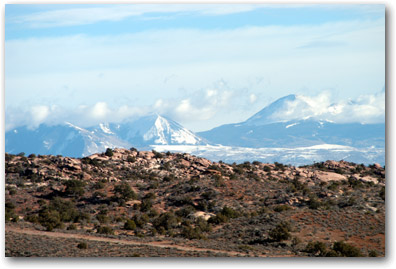
|
|
|
I arrived at the trailhead, and, not too surprisingly, I had the Tower Arch trail all to myself. After a short, steep climb, the sandy trail levels out for awhile, offering views of strange rock formations and hardy vegetation. The only animal I saw during the entire hike was a single hawk flying high overhead.
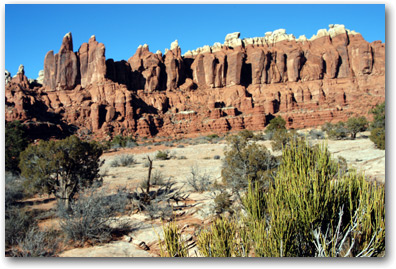
|
|
|
The trail is marked by cairns, small piles of rock that blend in naturally with the lanscape.
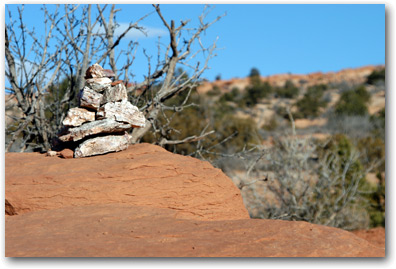
|
|
|
As it turns out, too naturally: the trail followed a wash for a ways, which curved around and around, gutting its way through the rock and showing the power of infrequent rainstorms. The wash made for such a natural trail that I missed the trail’s exit point. I continued down the wash for about a mile, growing increasingly concerned that I hadn’t seen a cairn in awhile, but confident I could find my way back with the help of a handheld GPS receiver and not really caring: it was a cool hike, even if I wasn’t on the trail.
Eventually the wash ended in a steep, 20-inch wide crevice carved through the rock and dropping some two dozen feet below. It was clear I wasn’t going through that 20-inch crevice, and there was no other option but to turn around. So I backtracked the mile until I found the turn I missed.
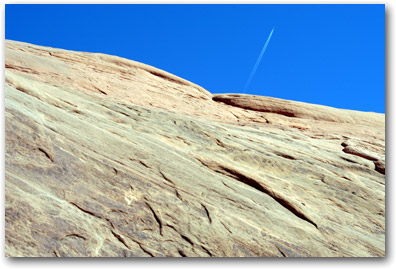
|
|
|
It was still a ways to go to the arch, which would not become visible until a turn at the end of the trail. Portions of the trail were beach-grade sand, the type where you climb up two steps and sink back one. I was getting a good workout: I was breathing heavily and my heart was racing. But I was also sick, and knew how stupid I was being by picking out one of the most strenuous and isolated hikes in the Park. Still, the scenery made it easy to take my mind off of how yechy I was starting to feel. A deep, blue sky and utter, complete silence made the experience very spiritual. At one point, out of curiosity I whipped out my cell phone to see if there was a signal. There was none. This was truly getting back to nature, and I had only myself to rely on. That was both empowering -; and a bit scary.
I eventually arrived at the Tower Arch, and it was a nice payoff for the hike. I rested there for awhile, taking pictures and enjoying a granola bar and Gatorade.
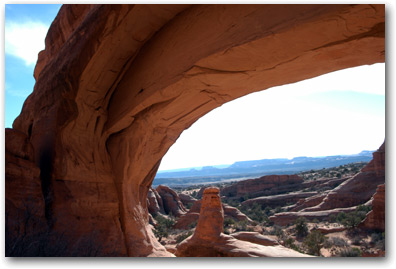
|
|
|
The hike back to the car was less strenuous: most of it was downhill. With some daylight left, I tried to go on a Jeep road that veered off from the unpaved road. It was fun for awhile, but I reached a point where the road became very steep. Around this point, someone had left a broken-off sidestep rail as a testimony, and no doubt warning, of what was to come.
I turned around.
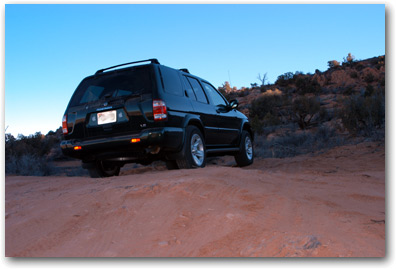
|
|
|
For those keeping score, you may remember that a tire on my Pathfinder began to fall off after my last service visit; the dealership forgot to screw the tire back on after a tire rotation. Well, after some rough dirt and offroad driving, the tire stayed on, minimizing my fears that damage had been done to the vehicle.
For some sunset pictures, I made the short hike to Broken Arch, so named because a rather large section of the arch fell down one morning in the dead of winter many decades ago. Thankfully, no one was there at the time.
As the sun fell, so did the temperature, into the low 40’s and soon into the upper 30’s. I waited until the sky was a dark crimson blue and then retreated to my car. It was a moonless night, and I waited for the stars to poke through the sky -; first a few, then a few dozen, and finally thousands. The stars in Utah are incredible, and unlike anything you’ll see on the East coast. Stare up at the heavens for a few minutes and you’re almost guaranteed to see a shooting star or two.
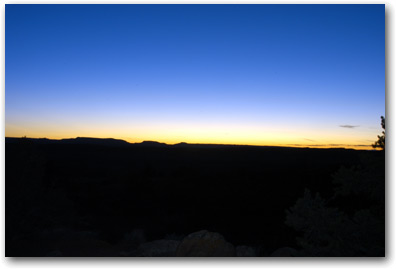
|
|
|
I only had one full day scheduled for Moab because, after all, this was a ski trip and I didn’t know whether temperatures and snow conditions would permit hiking. The rigorous hiking ensured that I wasn’t going to quickly throw my cold; the next morning, I had one of the worst sore throats I’ve ever had. My next destination was Las Vegas, about a day’s drive, where I would spend several nights while covering the Snowsports Industry Association trade show. And hopefully have a chance to get better before heading to Steamboat Springs, Colorado.
All photos by M. Scott Smith.
M. Scott Smith is the founder and Editor of DCSki. Scott loves outdoor activities such as camping, hiking, kayaking, skiing, and mountain biking. He is an avid photographer and writer.